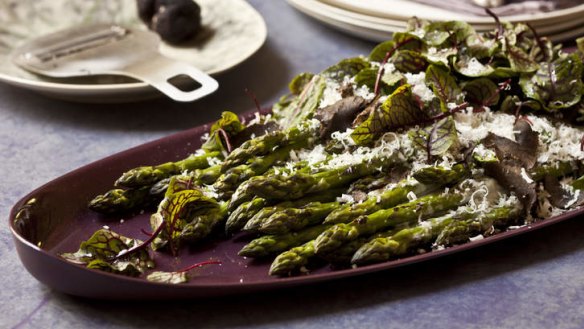Slow, steady wins taste

One of my early memories is watching asparagus pickers along the river flats of the Lachlan in Cowra in the 1960s and early 1970s, with the patient draught horses standing for long periods and pulling the harvest cart. The hilled-up rows were up to a metre high.
Asparagus is a true perennial crop and unique among vegetables in that it can crop for up to 20 years once planted. The key lies with the soil, which is perhaps your biggest challenge if you live in the Canberra region. You will need to have at least 10 plants if you want to regularly cut sufficient spears to feed a family of four.
Asparagus does best in deep, well-drained loamy soils, made rich with plenty of compost and old manures. It will not grow well in poorly drained clay soils as the roots will begin to rot off unless the water can drain away.
In our early days at Loriendale, we planted two rows of asparagus but found the production quite limited.
Below the topsoil was a shale-rock strata that was blocking off the roots from penetrating deep into living soil. So we chose a new location with much deeper soil and mixed in river sand to ensure good drainage.
Asparagus shoots are the tender new growth of spring. Once they emerge from the soil they turn green. If you want beautiful white asparagus spears hill up the bed to as much as 80 centimetres or 100 centimetres. This can require an awful lot of good topsoil and compost, but you can consider it an investment for 15 or 20 years of asparagus.
You can propagate asparagus from seed in early summer, transplanting them into individual pots when they are 15 centimetres to 20 centimetres tall for later winter planting in the garden.
But the best approach is to buy asparagus crowns from your local garden centre. To plant crowns, dig well down into the mounded hill and spread the roots out evenly in all directions. Cover with at least eight to 10 centimetres of soil, and add still more soil as the first shoots appear.
Spacing between plants should be at least 50 centimetres.
Apply generous amounts of mulch each year and keep the bed weed free. You can give an annual feed of a long-life organic pelletised fertiliser into the top few centimetres of the garden bed. If you have well-established asparagus, you can simply expand by digging up one or more crowns and dividing them into two sections by carefully cutting or prising the crown apart. But to do this you need crowns that have been growing for at least four years.
Asparagus is a long-term venture so don't expect a crop in the first year after planting. Let the first long slender shoots keep growing to balance the root growth. They will produce fern-like foliage over time - to be trimmed back only next autumn when they have died off. In the second season, take just two or three spears from each plant and allow the remainder to turn into fern foliage.
When harvesting, cut the spears off with a sharp knife, well down into the soil. If you have hilled up to produce the tender white spears, cut them at a length of about 20 centimetres.
The harvest season is in late spring and can continue for up to six weeks. When the plants are well established, pick every few days to keep the production going. Always allow some of the shoots to grow into the ferns for the plants to breathe.
The reward for your patience will be that you are growing a food fit for royalty.
>> Owen Pidgeon runs the Loriendale Organic Orchard, near Hall.
This week
■ Seedlings of silverbeet and spinach can be planted into a sunny garden bed now. Provide some cover protection overnight while they are getting established.
■ Begin planting out long-keeping varieties of onion seedlings. Mix some lime into the garden bed, as onions do not like acidic soils.
■ Sow rows of shelling peas and snowpeas in a sheltered bed that gets lots of sunshine. The seeds will take some time to germinate but they will provide an early summer crop. Plant to a depth of five centimetres and set up a wire mesh support.
■ As well as planting asparagus crowns, you can consider planting out rhubarb sets into deep friable soil. You can also plant out artichokes.
■ Complete trimming of old leaves from strawberry plants and transplant established new strawberry runners into a bed with lots of added compost.
■ Red, white and blackcurrants as well as gooseberries are suited to Canberra, surviving well in heavy soils and through cold winters. They will produce an early summer crop.
Restaurant reviews, news and the hottest openings served to your inbox.
Sign up